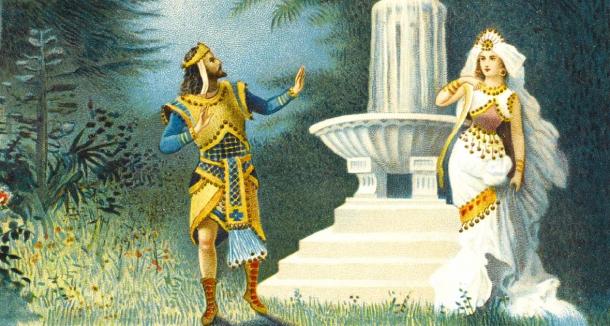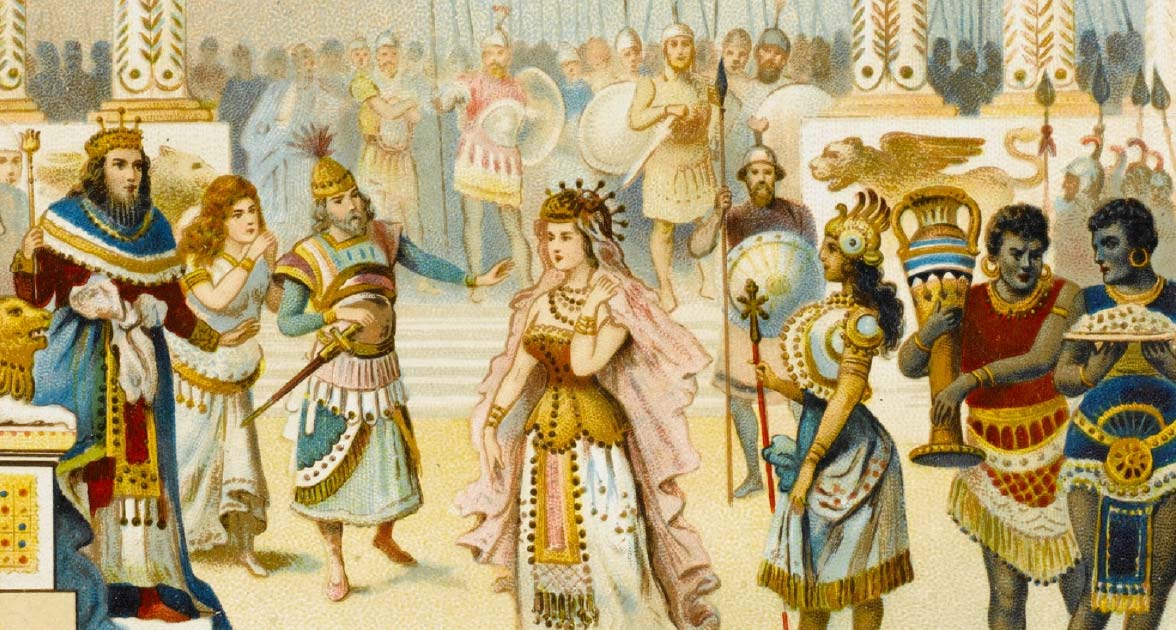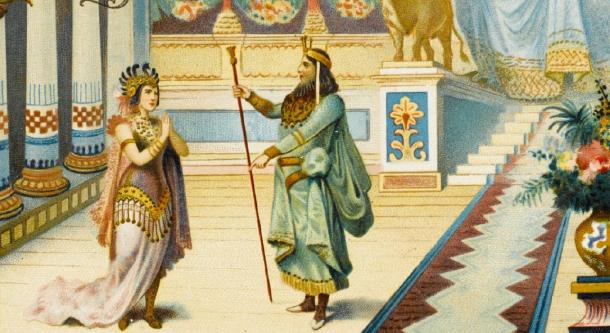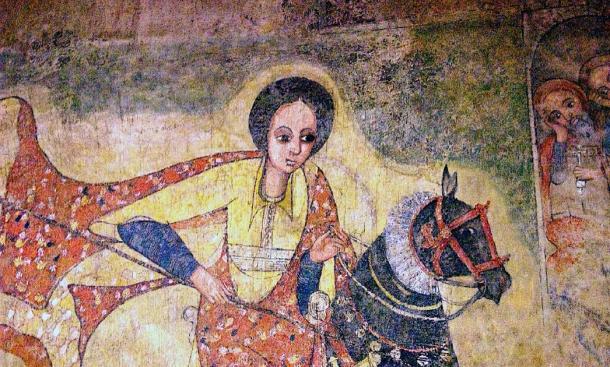 |
| There is a story that King Solomon tricked the Queen of Sheba into spending the night with him. |
How A Legend Was Born
.
she is considered by the Ethiopians to have existed, and is
revered as the mother of their nation - she is believed to have been the
founder of the Solomonic dynasty, which ruled over Ethiopia until its last
ruler, Haile Selassie I, was deposed in 1974.
.
 |
The Queen of Sheba departs her land with many gifts for King Solomon.
|
Wu Mingren
The Queen of Sheba is an enigmatic figure found in all
three of the Abrahamic faiths, i.e. Judaism, Christianity, and Islam.
In addition to her presence in these three religions,
the Queen of Sheba plays an important role in the history and identity of the
Ethiopian people.
While most people regard the Queen of Sheba to be a
legendary figure, she is considered by the Ethiopians to have existed, and is
revered as the mother of their nation.
Moreover, she is believed to have been the founder of
the Solomonic dynasty, which ruled over Ethiopia until its last ruler, Haile
Selassie I, was deposed in 1974.
 |
| The Queen of Sheba meets with King Solomon. |
Nevertheless, the different traditions have given her
different names.
For instance, Arab sources refer to the Queen of Sheba
as Balqis or Bilqis, while a Christian source, De Mulieribus Claris or De Claris Mulieribus (meaning ‘Concerning Famous Women’), written
by the 14th century Florentine author Giovanni Boccaccio, refers to the
legendary queen as Nicaula.
As for the Ethiopians, they refer to the Queen of
Sheba as Makeda.
This name is found in the Kebra Nagast (meaning ‘The
Glory of Kings’), which was written in the 14 th century and considered to be
Ethiopia’s national epic.
The Queen of Sheba in the Hebrew Bible
In the Hebrew Bible, the story about the Queen of
Sheba is found in 1 Kings 10: 1-13, and 2 Chronicles 9: 1-12, though both
accounts say more or less the same thing.
In both of these accounts, the Queen of Sheba visited
Solomon in Jerusalem, as she had “heard of the fame of Solomon concerning
the name of the LORD,” and wanted to “prove him with hard questions”.
For her visit to Jerusalem, the Queen of
Sheba brought with her “a very great train, with camels that bare spices,
and very much gold, and precious stones”.
The account then states that the Queen of Sheba asked
Solomon the questions that she had set, and the king was able to answer all of
them.
The queen was overwhelmed by Solomon’s
wisdom, as well as the wealth of his kingdom, “And when the queen of Sheba
had seen all Solomon's wisdom, and the house that he had built, And the meat of
his table, and the sitting of his servants, and the attendance of his
ministers, and their apparel, and his cupbearers, and his ascent by which he
went up unto the house of the LORD; there was no more spirit in her”.
Needless to say, the presence of the Queen of Sheba in
the Hebrew Bible is meant to show off Solomon’s wisdom, the wealth of his
kingdom, and to glorify God.
At the same time, the account provides us with a
tantalizing glimpse of the wealth possessed by the Queen of Sheba:
“And she gave the king a hundred and
twenty talents (about 4 tonnes) of gold, and of spices very great store, and
precious stones: there came no more such abundance of spices as these which the
Queen of Sheba gave to King Solomon. And the navy also of Hiram, that brought
gold from Ophir, brought in from Ophir great plenty of almug trees, and
precious stones”. 1 Kings 10:10 New International Version (NIV) Bible
Solomon, likewise, treated the queen
with great generosity during her stay in Jerusalem, “And King Solomon gave
unto the Queen of Sheba all her desire, whatsoever she asked, beside that which
Solomon gave her of his royal bounty”.
 |
| Bilqis reclining in a garden, the Queen of Sheba facing the hoopoe, Solomon’s Messenger. |
It may be mentioned that this legendary queen makes a
cameo in the New Testament.
In Matthew 12:42, Jesus rebukes the
scribes and Pharisees who were asking him for a sign by saying “The queen of
the south shall rise up in the judgment with this generation and shall condemn
it: for she came from the uttermost parts of the earth to hear the wisdom of
Solomon; and, behold, a greater than Solomon is here”.
The ‘queen of the south’ is equated with the Queen of
Sheba.
In addition, this Old Testament story is re-cast in a
new light by Christians. For instance, the Queen of Sheba’s visit to Solomon is
seen as a metaphor for the submission of the Gentiles to Christ.
In addition, the queen is said to foreshadow the
Virgin Mary through her chastity. And her gifts of gold, spices, and stone, are
said to mirror the gold, frankincense, and myrrh presented by the magi to the
infant Jesus.
Embellishments About the Queen of Sheba
The narratives about the Queen of Sheba in both the
Hebrew Bible and the Qur’an have some gaps in them, and commentators and
religious scholars in later times have attempted to fill them.
As a result, the stories surrounding the Queen of Sheba were embellished and became even more colorful than they already were.
 |
| Many embellishments, such as the glass floor story, have been written about the Queen of Sheba. |
As a result, the stories surrounding the Queen of Sheba were embellished and became even more colorful than they already were.
An embellishment of this story states that Solomon’s
djinns were afraid that the king would be tempted to marry the queen, and one
of them whispered to Solomon that the queen had hairy legs, and the hooves of
an ass.
Solomon, being curious, ordered a glass floor to be
built before his throne.
When the queen lifted up her skirt to cross the
‘water’, it was revealed that she did have hairy legs.
Solomon ordered his djinns to create a depilatory for
the queen. The story ends without concluding if Solomon married the Queen of
Sheba.
In the Hebrew Bible, the Queen of Sheba is said to
have tested Solomon with riddles, but these riddles are not found in the text
itself.
These riddles, however, can be found in the Midrash, a
compilation of writings involving the critical explanation / interpretation of
the Hebrew Bible by ancient Jewish authorities.
In the Midrashic account, the Queen of
Sheba’s first riddle is as follows, “How can a woman say to her son: ‘Your
father is my father; your grandfather, my husband; you are my son, and I am
your sister?’”.
Solomon’s answer to the riddle was the two daughters
of Lot, who got their father drunk, had sex with him, got pregnant as a result,
and bore sons.
Next, the Queen of Sheba brought a group of children
before Solomon. They were all of the same height and wore the same attire. The
queen told Solomon to distinguish between the boys and girls.
The king had nuts and roasted ears of corn scattered
before the children.
The boys, who were not bashful, collected them, and
tied them within the hems of their garment, while the girls, who were bashful
tied them within their outer garments, since their bodies would be revealed if
they had done as the boys did.
Lastly, the queen brought a group of men before
Solomon and asked him to distinguish between the circumcised and the
uncircumcised.
Solomon had the Ark of the Covenant
brought out and opened, and the “circumcised stood or bowed their bodies to
half their height, while their countenances were filled with the radiance of
the Shekhinah,” whereas the uncircumcised fell prostrate on the ground.
The most significant embellishment to the story,
however, is found in the Kebra Nagast.
In this text, the Queen of Sheba is called Makeda, and
is said to have stayed in Jerusalem for six months, where she learned from
Solomon.
On the last night of her stay, she was tricked by the
king into having sex with him.
According to the tale, Solomon had invited the queen
to a banquet, during which spicy food (to induce her thirst) was served.
After the banquet, the king invited her to stay in his
palace for the night. The queen agreed, on the condition that he would not take
her by force.
Solomon agreed to that, on the condition that the
queen would not take anything from him by force. Makeda, though slightly
offended, agreed.
In the middle of the night, Makeda woke up, as she was
very thirsty, and reached for a jar of water close to her bed.
Solomon appeared, warning the queen that if she drank
the water she would be breaking her oath.
Makeda’s thirst, however, was too strong and she drank
the water, thus freeing Solomon from his oath. The two ended up spending the
night together.
Makeda became pregnant, and when she returned to her
kingdom, gave birth to a son, Menelik, who became the first emperor of
Ethiopia.
Where Was the Queen of Sheba From?
Lastly, arguably the greatest mystery surrounding the
story of the Queen of Sheba is the location of Sheba itself.
In the Kebra Nagast, the Queen of Sheba is said to be
from Ethiopia.
The identification of Ethiopia as Sheba is supported
by the 1st century AD Jewish historian, Josephus, who identified the Queen of
Sheba as the Queen of Egypt and Ethiopia.
One view held by modern scholars today is that the
Queen of Sheba came from Axum, an ancient kingdom in Ethiopia.
An alternative suggestion is that the Hebrew word
‘Sheba’ is derived from the Arabic ‘Saba’, an ancient kingdom located in the
southwestern corner of the Arabian Peninsula, in what is today Yemen.
Although the archaeological evidence showed that there
was indeed a civilization thriving in that region, the artifacts were dated to
the 7th century BC, about 300 years after Solomon’s reign.
During the 1980s, however, new discoveries showed that
the Sabaean civilization was already in existence during the 10th century,
making it not impossible that a queen from there could have visited Solomon in
Jerusalem.
In any case, conclusive answers have yet to be found,
and the question about the location of Sheba is still, at present, left open.
By Wu Mingren
I am a university student doing a BA
degree in Archaeology. My interests range from ‘conventional’ to ‘radical’
interpretations of the archaeological/textual/pictorial data set. I believe
that intellectual engagement by advocates from both ends of the spectrum would
serve to enhance our understanding of the past. In addition, such discussions
would serve to bring Archaeology to a wider audience as well as to stimulate
their interest, curiosity, and critical thinking of such issues.
https://www.ancient-origins.net/history-famous-people/queen-sheba-0013158
 |
17th century AD painting of the Queen of Sheba from a church in Lalibela, Ethiopia.
|

No comments:
Post a Comment